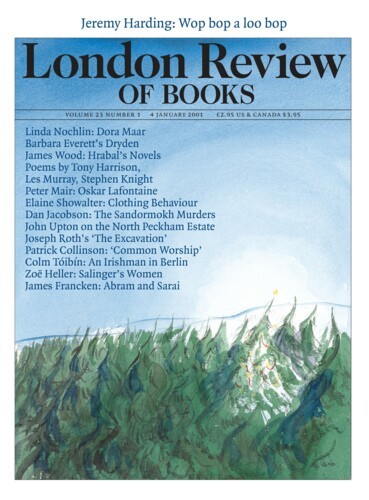Leaving the exhibition of Turner watercolours at the Royal Academy’s Sackler Galleries, I looked down Piccadilly towards the Ritz and Green Park and tried to see the view as Turner might have done. The day was a little misty (he would have liked that) and the sun a brightness hidden in cloud. I could make a guess at how he would have handled the distant trees in the park and the disappearing traffic. To make a Turner of the world, it became clear, you must take the long view, concentrate on the middle and far distance, and only register near objects in the low-resolution periphery of the retina. Look at the world in that way and it becomes clear why it doesn’t matter that Turner, who could capture the fine detail of a distant hillside and the translucence of vaporous air with such refinement, peopled his pictures with funny, clumsy little figures. Indeed you begin to wonder whether, if they were less odd, the eye might linger too long on them, not look past them to the blue hills and the ravelling clouds. Eric Shanes’s essay in the catalogue which he edited (Thames and Hudson, £35) suggests that the contrast between dumpy people and noble nature was intentional. ‘Staffage’ is the word for human and animal extras, I find, and David Teniers the Younger, whose work Turner admired, is offered as the source of their plain looks. Whatever his narrative intention, foreground accents – not just people, but boats, buoys, goats, ducks – are important parts of the visual machinery. They provide a first stopping place for the eye and give the bottom note in the register of aerial perspective which runs from bright clothes and dark rocks and trees to diaphanous veils of pale cloud. The scale and order of recession in the landscapes depends on them. They are little dramas on the human scale which lead us on to bigger things.
Painting the distant scene presents problems which foregrounds do not. Sargent, who was a watercolour painter of the other school (rough paper, big brushes, flashy blending and bleeding of colour), said that he could not handle a wide view. Turner, even when he is close to a subject, hints at huge surrounding spaces.
These are finished watercolours, the kind he exhibited and sold, both to his loyal patrons and to engravers. His output was prodigious (nearly two thousand of these finished drawings) and the review the catalogue gives of his relations with patrons, and of what is known about his way of working, is illuminating. The watercolours were painted in the studio, based on sketches and notes he made during his travels, or even on drawings by others. Sometimes he set up his own production line – not wanting to waste the time it took for each layer of wash to dry. He used excellent materials: it takes a robust sheet to stand the rubbing, scratching out of highlights with thumbnail and knife, soaking and sponging to which he subjected his paper. He acquired new colours (cobalt blue, chrome orange, French ultramarine) as they came on the market and extended his range of effects by using gouache as well as watercolour.
Two of Turner’s great patrons were Walter Fawkes and B.G. Windus. Contemporary paintings of their rooms show the hang (one of several words which is making the move from curator’s jargon to the common vocabulary) in Fawkes’s house in Grosvenor Place and Windus’s at Tottenham. The pictures are framed in gold and close-mounted as Turner intended – no modern cream surrounds. The sublime seems quite at home in a drawing-room. Details of technique and display explain, in part, Turner’s phenomenal productivity, and many of his pictures, both those which were ends in themselves and others which were supplied to be engraved, were made to order. Despite his businesslike management of sales and production, invention did not fail him.
Both kinds of patron wanted more than topography. The best of the pictures they received challenge nature; Turner’s suns, rocks and rainbows are not representations so much as evocations of rare imagined states of land and weather, no more common in the real world than Byron’s dramas.
Send Letters To:
The Editor
London Review of Books,
28 Little Russell Street
London, WC1A 2HN
letters@lrb.co.uk
Please include name, address, and a telephone number.


